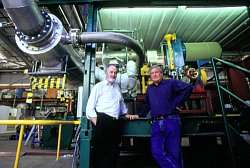This topic covers issues related to energy generation, conversion, transportation and consumption and how the industry is addressing the challenge of energy efficiency in general.
innovations-report provides in-depth and informative reports and articles on subjects ranging from wind energy, fuel cell technology, solar energy, geothermal energy, petroleum, gas, nuclear engineering, alternative energy and energy efficiency to fusion, hydrogen and superconductor technologies.

In the search for low-cost color displays that do not drain a computer’s battery, the polymer light-emitting electrochemical cell (LEC) may be the next answer to the problem, according to an international team of electrical engineers.
“The color-variable LEC can provide a solution to simple, low cost color displays,” Cheng Huang, graduate student in electrical engineering at Penn State told attendees today (Aug. 20) at the 224th American Chemical Society annual meeting in Boston.

A series of obstacles fell before the onslaught of a Penn State engineering graduate class as they tackled and found solutions to all the barriers preventing development of a hybrid fuel cell automobile using hydrogen fuel cells and battery storage.
“The professors asked the class to solve the problem of hydrogen odorization,” says Jamie Weston, graduate student in energy and geoenvironmental engineering. “We quickly came up with a solution and, took the rest of the course to develop our so

Using photon emissions from individual molecules of silver, researchers at the Georgia Institute of Technology have created what may be the world’s smallest electroluminescent light source.
Believed to be the first demonstration of electroluminescence from individual molecules, the work could lead to new types of nanometer-scale optical interconnects, high-resolution optical microscopy, nanometer-scale lithography and other applications that require very small light sources. And becaus

An enormous source of clean energy is available to us. We see it almost every day. It’s just a matter of harnessing it.
The problem with solar energy is that it has not been inexpensive enough in the past. David Kelley, professor of chemistry at Kansas State University, developed a new type of nanoparticle — a tiny chemical compound far too small to be seen with the naked eye — that may reap big dividends in solar power.
Kelley’s team is studying the properties and tech

New technology for generating power from coal mining waste was launched by the Federal Minister for Industry, Tourism and Resources, the Hon. Ian Macfarlane, at CSIRO in Brisbane today.
The revolutionary technology has the potential to significantly reduce greenhouse gases and bring big savings to mining companies operating coal mines.
The CSIRO-Liquatech hybrid coal and gas turbine system unveiled at the Queensland Centre for Advanced Technologies will generate electricity from wa

The kerosene that lights your heater or stove might be the same type of fuel powering the nation’s next space vehicle.
Kerosene — almost as common to American life as gasoline — is being considered as a fuel for two main engine candidates for a second generation reusable launch vehicle, now in development by the Space Launch Initiative. The Initiative is NASA’s technology development program to design a complete space transportation system with increased safety and reliability at a lower c